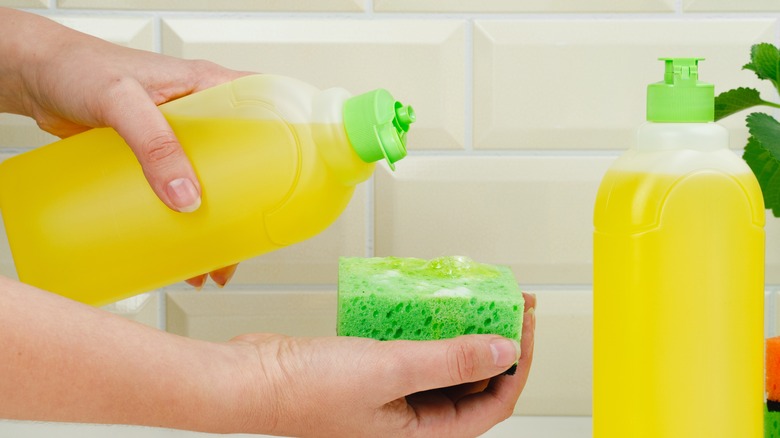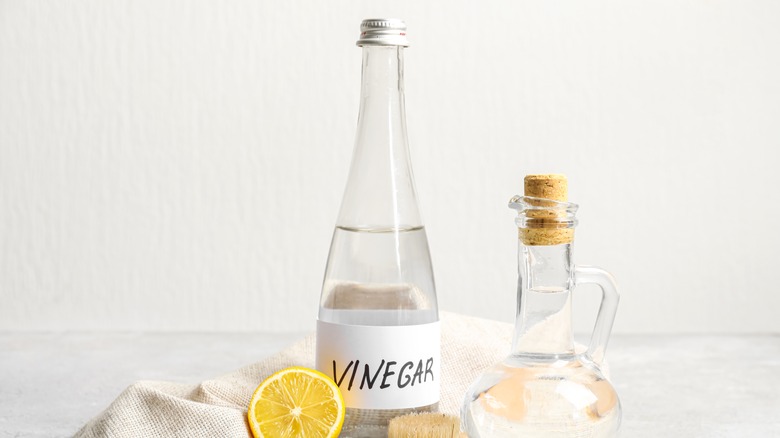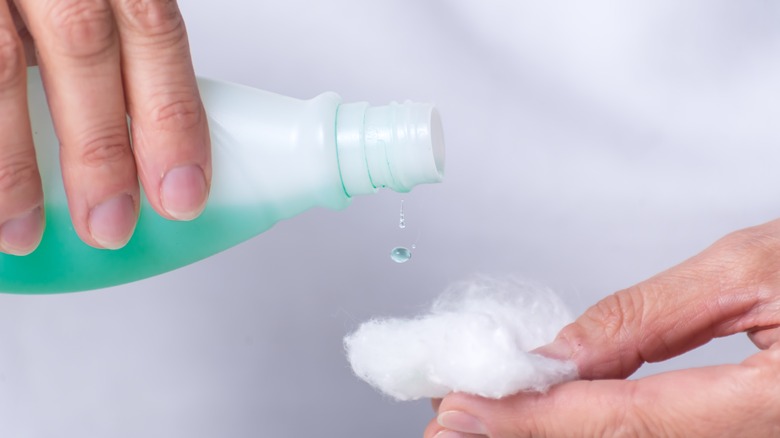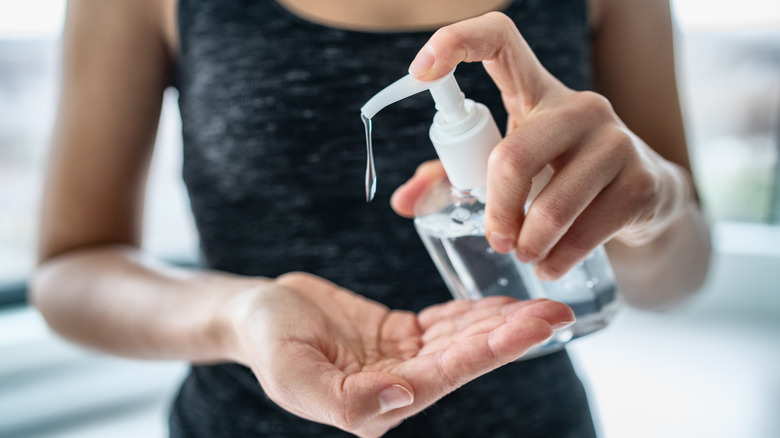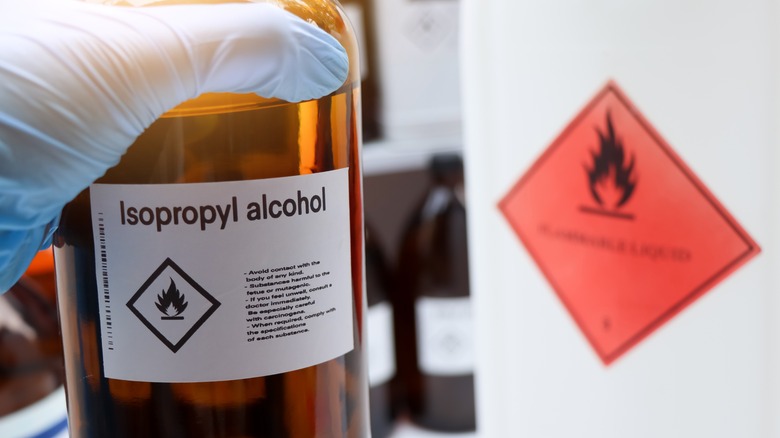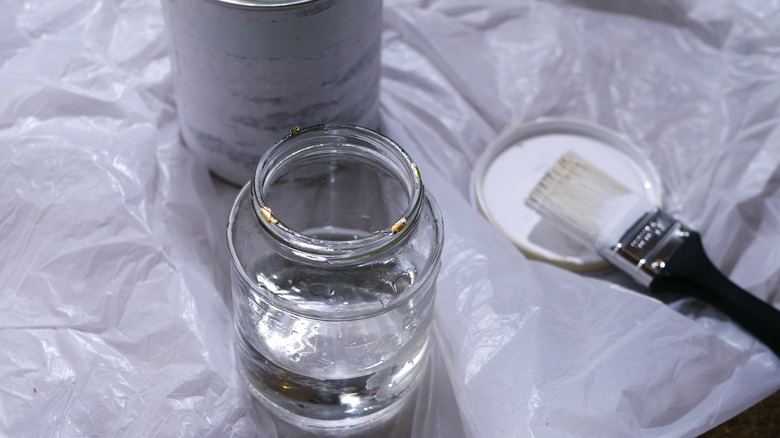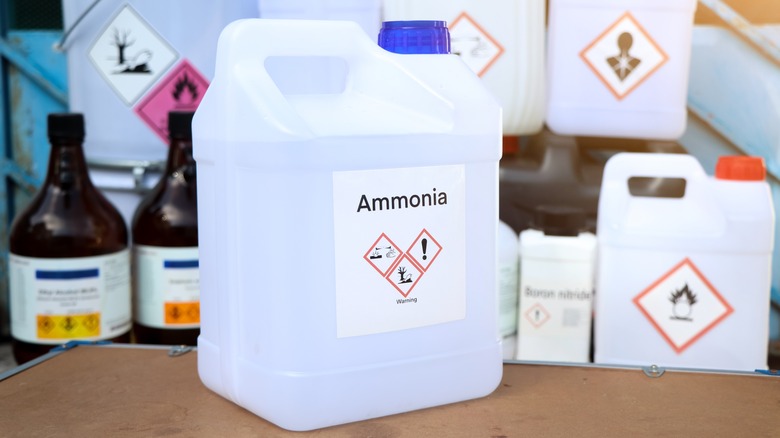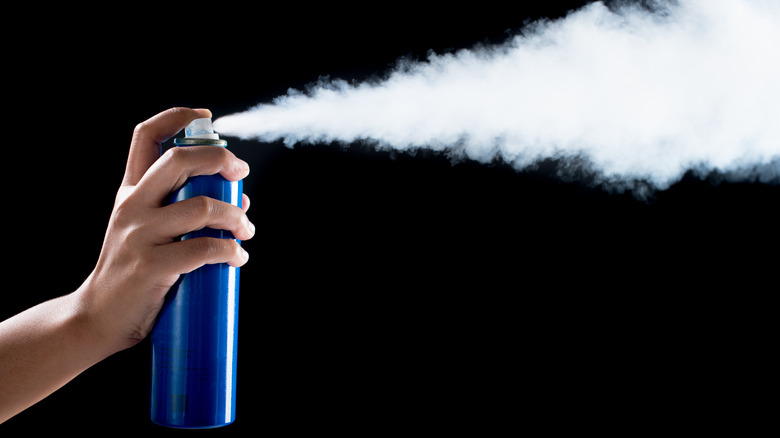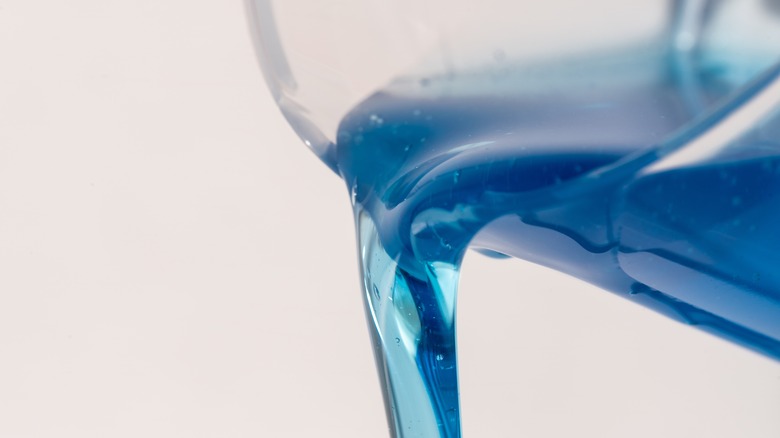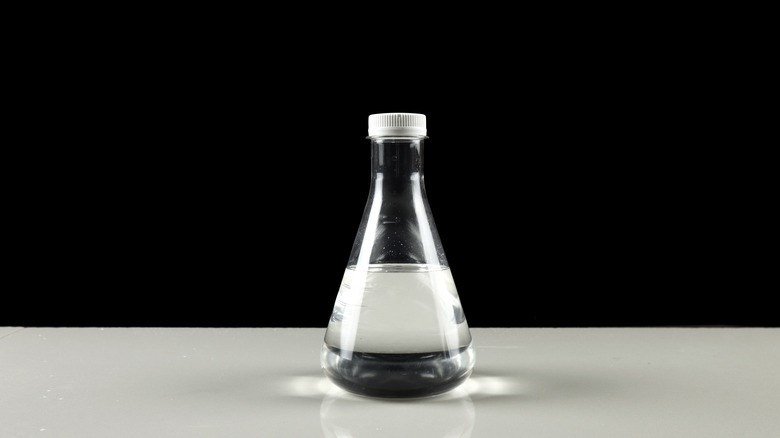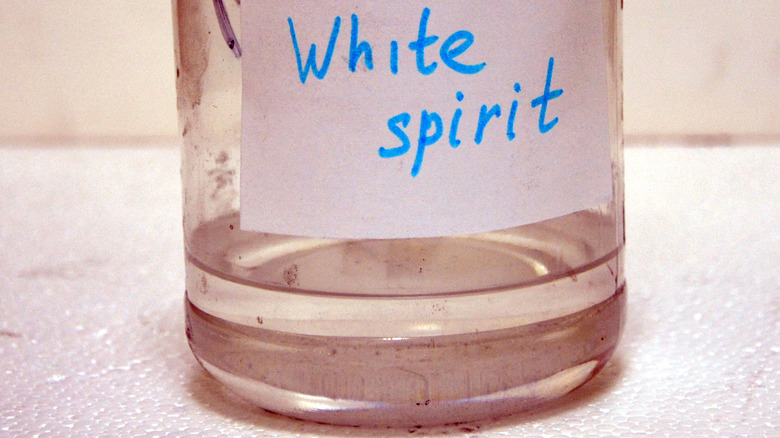The 12 Best Ways To Remove Paint Stains From Your Favorite Clothes
Paint stains on clothes are notoriously difficult to remove. The longer they stay on the fabric, the harder it is to wash them off. However, not all paint stains are made equal. Water-based paint stains — including acrylic, latex, and finger paint — can be easy to treat, especially when fresh. But oil-based paints such as enamels and modern craft paints, among others, contain oil that binds the pigment to the textile. The type of fabric also determines the best method to remove the stains and whether to use hot or cold water. Denim, for example, can handle a lot of liquids and solvents that break down the paint. But the same can't be said about silk, nylons, or other delicate materials.
Whichever way you choose to deal with paint stains, you should act quickly and follow the garment care directions on the label. Most importantly, you should always test the solution on a small part of the fabric first. Some solvents could cause damage to the garments or make the color run. And before pretreating or treating the paint, always place a few paper towels under the stain to prevent the paint from smearing the rest of the garment.
Dish soap for oil- and water-based paint stains
Fresh water-based and oil paint stains are easy to wash out with water and dish soap. Before applying this solution, gently scrape the excess paint off the garment with a spoon or a dull knife. Next, flip the garment inside out and place the back of the stain under warm running water to flush out the paint particles. The repeated flushing will take out most of the stain, leaving traces of paint behind. To remove them, pour a few drops of dish soap directly on the paint stain. Don't rub the dish detergent into the stain since that will push the paint deeper into the fabric. Finally, rinse the back of the stain under cold running water. Repeat the process until the stain is gone, then wash the garment separately.
Dish soap contains sodium lauryl sulfate, a strong chemical that breaks down the paint stain and binds with the particles, making it easier to remove them. However, there's a risk it could cause the colors to run. So always test the dish detergent on a hidden part of the garment first. Also, silk and other delicate fabrics are some of the things you should never clean with dish soap since it could damage them.
Vinegar for dry water-based stains
If you don't spot the water-based paint stain in time, then you'll need vinegar to remove the dry stain from the clothes. After scrubbing as much of the dry paint as you can off the garment with the back of a knife, apply a few drops of vinegar to the stain. You can use either distilled white vinegar or apple cider vinegar for this method. Set the garment aside for 15 minutes to allow the acidic liquid to penetrate and saturate the dried paint. With a toothbrush, brush the stain in small circles to get the paint off the fabric. Finally, hold the back of the stain under cold running water to flush the vinegar and paint out. Repeat as necessary until you don't see any traces of the stain.
Vinegar can be a versatile cleaning tool. It contains acetic acid, a compound that not only breaks down paint but can strip it off altogether. When applied to the dry paint stain, the acid breaks the bond between the paint and the fabric. That said, undiluted vinegar isn't the kind of liquid to apply to all clothes. It can damage some clothing, including delicate fabrics, even when mixed with water. Also, avoid using vinegar to remove paint stains on clothes that contain elastic, such as swimsuits and bras.
Nail polish remover for water-based paint stains
Nail polish remover is the right solvent for dry water-based paint stains that resist other methods. Pretreating the stain to remove excess paint with a blunt-edged utensil helps minimize the affected area and avoid expanding the stain. To apply the solvent, soak a cotton swab in non-acetone nail polish remover and dab it on the paint stain. Allow 5 minutes before brushing the paint surface gently with an old toothbrush. Once you have dislodged the stain from the fabric, turn the garment inside out and run cold water through the back of the stain. After the paint is removed, wash the garment separately in cold water using a normal cycle.
The active ingredient in many non-acetone nail polish removers is ethyl acetate. This compound is used in the paint industry as a dissolver that adjusts the viscosity of the paint. When applied to acrylic or latex stains, it can break the bond between the paint and the fabric. As usual, you should be careful when applying the solvent to clothes since it can stain them. In the case of colors, the solvent might bleach the fabrics.
Hand sanitizer removes latex paint
Hand sanitizers aren't just for killing germs; they can also remove latex paint stains. For this purpose, a gel sanitizer is more effective and easier to apply than a foam product. To use it on the pretreated latex stain, squirt the gel directly on the paint and let it sit for a few minutes. Poking the stain with an old toothbrush, check that the surface has softened and is easy to remove. If it's still hard, then the hand sanitizer doesn't have a high alcohol percentage, and you need to give it a few more minutes. Finally, brush the latex stain off with the toothbrush and rinse the affected area from the back with running water.
The active ingredient in hand sanitizers is either ethyl alcohol or isopropyl alcohol. Most of the sanitizers on the market contain a minimum of 60% alcohol to be effective. However, some products have higher alcohol concentrations, making them better at removing latex paint stains. That said, it's not safe to use the sanitizer on all fabrics because it might lead to faded colors. Also, use only transparent hand sanitizers since the ones that have colors could stain clothes.
Rubbing alcohol to remove acrylic stains
You can easily remove dried paint with rubbing alcohol. It is most effective against acrylic and latex paint stains. With the stain already pretreated, wash it with soap and water to get as much of the paint off. Then, dab a cotton ball in rubbing alcohol and gently rub it over the stain. Make sure to work the alcohol into the fabric to reach the paint particles already absorbed by the textile. To avoid spreading the dissolved paint, try to stay within the edges of the stain. After letting it sit for a few minutes, use a wet microfiber cloth to wipe the stain off. Keep working with the alcohol and damp cloth until you can no longer see any traces of the stain.
Rubbing alcohol contains about 70% isopropyl alcohol. That's usually enough to break down the water-based paint stains and help you remove them without a hassle. However, this much isopropyl alcohol isn't always safe to apply to colors. The chemical not only works on paint stains but also dissolves dyes in clothes, causing fading and color runs.
Turpentine or paint thinner for oil paint stains
Oil paint often contains linseed or sunflower oil and pigment, which require a stronger solution to remove the paint stain. This double whammy of paint and oil stains calls for turpentine. If you don't have turpentine at hand, then paint thinners will do in a pinch. After scraping off the excess paint, press a clean cloth gently over the stain to absorb the oil and paint. Next, and with protective gloves on, apply a few drops of the solvent to the stain, then set it aside for 5 to 10 minutes. Using a paper towel, blot the stain a few times, without rubbing it, to soak up the dissolved paint. Repeat the treatment until the stain is clean, then wash it with dish soap and water.
If you're using a paint thinner, make sure it's the one listed on the oil paint can. Paint thinners vary wildly in their chemical composition, which is why different paint products use different thinners. If you use the wrong thinner, you might make the stain worse. In addition to being flammable, neither of these solvents should be used on acetate clothing. Moreover, turpentine might cause discoloration in the treated garments.
Ammonia for oil paint
Ammonia is another ingredient that you might have around the house and can be used to remove oil paint stains from clothes. But it doesn't work alone, and you'll need to mix it with dish soap. As part of the pretreatment, put the back of the stain under hot water to get rid of as much oil as you can. To prepare the stain removal solution, mix 1 tablespoon of ammonia and 1/2 teaspoon of dish soap into 4 cups of warm water. Apply the mixture to the stain and set it aside for half an hour. With a clean cloth or a paper towel, blot the stain repeatedly to absorb the paint and oil. Rinse thoroughly under cold water and wash the garment.
The dish soap here will help bind the ammonia solution to the fabric for as long as you leave it on the stain. But it's the ammonia that breaks down the organic compounds in the oil and paint. This is why this method isn't recommended for fabrics such as wool and silk. Also, avoid using dyed ammonia products since they are more likely to stain the clothes.
Duct tape removes dry latex
Duct tape is a creative way to deal with paint stains on clothes. If you have a water-based paint stain, such as latex, that has dried out, a piece of duct tape could come in handy. But before you can use it, you'll need to break the dry surface of the stain into fragments with a spoon. Keep working on the fragments to loosen them up and make the tape's job easier. Next, press the duct tape strip firmly on a small part of the dry stain, then pull it out quickly. You'll see that pieces of the paint get stuck in the tape and come out easily. When there are no more paint fragments to lift off, wash the stain with dish soap and warm water.
This mechanical method of removing paint stains doesn't involve chemicals. It's recommended when you can't scrape off the dry paint because the stain is too small or the material is too fragile. However, it can still cause some damage to flimsy and delicate fabrics. This is why you only apply the strip to one part of the stain at a time. You shouldn't use the tape on the whole stain at once or you might tear up the garment.
Hairspray for wet and dry water-based paint
When water-based paint stains a piece of clothing and you only have hairspray available, it's all you need to prevent the paint from making a permanent mark on the garment. With the paint blob still wet on the fabric, scoop it off with a spoon, then rinse the back of the stain under warm running water. But if the paint is dry, apply the hairspray directly without pretreatment. Spritz the stain with enough hairspray to get it thoroughly soaked. Then set it aside for a few minutes to let the chemicals work through the stain. When the paint is soft, wipe it off with a clean cloth. Repeat the hairspray treatment until you're satisfied with the outcome, then wash the garment.
Hairspray has isopropyl alcohol at a 50% concentration. With such low denatured alcohol volume, you'll need a few applications to get rid of the water-based paint stains. On the downside, the oxidizing agents in the hair care product can stain clothes and cause discoloration. And since it contains butane, a highly flammable compound, it is best to avoid using it near a heat source or open fire.
Laundry detergent for all types of paint
Many laundry detergents are designed with various types of paint stains in mind. The advantage of using a laundry detergent is that it removes the stain without damaging the fabric or causing color loss. After pretreating the paint stain, mix your detergent of choice into warm water in equal portions. Use a clean rag to apply the solution to the stain and leave it for a few minutes. Poke the paint gently, and if it's soft, then it's ready; otherwise, apply more detergent solution and wait a few more minutes. Finally, scrub the stain off the fabric with the rag or a soft brush. Before you toss the garment in the washer, rinse it under running water.
Laundry detergents have all the ingredients you need to work through tough stains. While you can remove water-based paints with the normal laundry detergent you have at home, oil paint stains might require strong detergents in combination with stain removers. As long as you follow the instructions on the package of both the detergent and stain remover, you won't have to worry about ruining the treated garment.
Glycerin for oil paint
Glycerin is more than just a handy skin moisturizer. This natural ingredient works wonders on even the toughest of stains. Glycerin is a non-toxic compound that also goes into making soaps. That makes it an ideal option to remove oil paint stains from clothes. And best of all, it doesn't require mixing or preparation. Soak a cotton swab in the transparent liquid, apply it to the pretreated stain, then set it aside for 8 to 10 hours or just leave it overnight. When the paint has fully dissolved, come back with a damp cloth to wipe it clean. Finish off with a thorough rinse with warm water, then put the garment in the washer.
Glycerin contains chemicals that dissolve oil and help remove paint stains from garments. It works well on all fabrics. If you use the vegetable-based colorless glycerin, then you won't have to worry about staining or damaging the fabrics. There are no known effects on the dyes in the clothing either. However, some products have a yellow or brown color, and these could leave stains.
Mineral spirits for fresh oil paint stains
Mineral spirits, or white spirit, is a transparent liquid distilled from petroleum and used as a solvent. If you have an oil paint can, most likely it will suggest on the label to use mineral spirits to clean the paint brush. That's a dead giveaway that you can also use the solvent to get rid of oil paint stains on your clothes. Applying mineral spirits to fresh oil stains is straightforward. Dip a clean white cloth in the solvent, and blot the pretreated stain repeatedly. When the cloth is smudged with paint, switch to a clean part and repeat the treatment until the paint has all come off.
Mineral spirits has the same effect on stains as paint thinners. Both are solvents, but mineral spirits is the safer and more refined of the two. The liquid, however, has a kerosene-like odor and is a little oily. The treated clothes might retain the offensive smell and some oil residue, which requires washing with dish soap and water. Also, it's not recommended to use the potent solvent on synthetic materials, including acetate and rayon.

